
"Rauisuchia" is a paraphyletic group of mostly large and carnivorous Triassic archosaurs. Rauisuchians are a category of archosaurs within a larger group called Pseudosuchia, which encompasses all archosaurs more closely related to crocodilians than to birds and other dinosaurs. First named in the 1940s, Rauisuchia was a name exclusive to Triassic archosaurs which were generally large, carnivorous, and quadrupedal with a pillar-erect hip posture, though exceptions exist for all of these traits. Rauisuchians, as a traditional taxonomic group, were considered distinct from other Triassic archosaur groups such as early dinosaurs, phytosaurs, aetosaurs, and crocodylomorphs.
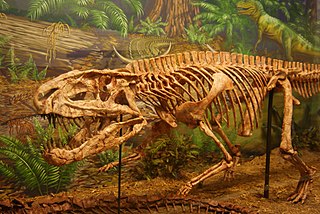
Postosuchus, meaning "Crocodile from Post", is an extinct genus of rauisuchid reptiles comprising two species, P. kirkpatricki and P. alisonae, that lived in what is now North America during the Late Triassic. Postosuchus is a member of the clade Pseudosuchia, the lineage of archosaurs that includes modern crocodilians. Its name refers to Post Quarry, a place in Texas where many fossils of the type species, P. kirkpatricki, were found. It was one of the apex predators of its area during the Triassic, larger than the small dinosaur predators of its time. It was a hunter which probably preyed on large bulky herbivores like dicynodonts and many other creatures smaller than itself.

Riojasuchus is an extinct genus of ornithosuchid archosaur from the Late Triassic (Norian) of Argentina. Ornithosuchidae was a widespread family of facultatively bipedal pseudosuchians with adaptations for scavenging. Riojasuchus is notable as one of the youngest and most complete members of the family. The type and only known species, Riojasuchus tenuisceps, was named and described by José Bonaparte in 1967. It was one of the first of many well-preserved Triassic archosaurs to be discovered in Argentina. The holotype specimen, PVL 3827, was found in the Los Colorados Formation of the Ischigualasto-Villa Unión Basin in northwestern Argentina.

Rauisuchidae is a group of large predatory Triassic archosaurs. Some disagreement exists over which genera should be included in the Rauisuchidae and which should be in the related Prestosuchidae and Poposauridae, and indeed whether these should even be thought of as separate valid families. Rauisuchids occurred throughout much of the Triassic, and may have first occurred in the Early Triassic if some archosaurian taxa such as Scythosuchus and Tsylmosuchus are considered to be within the family.
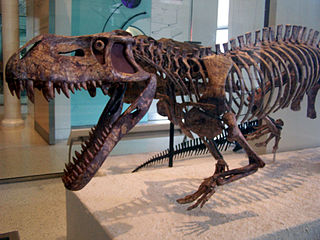
Prestosuchidae is a polyphyletic grouping of carnivorous archosaurs that lived during the Triassic. They were large active terrestrial apex predators, ranging from around 2.5 to 7 metres in length. They succeeded the Erythrosuchidae as the largest archosaurs of their time. While resembling erythrosuchids in size and some features of the skull and skeleton, they were more advanced in their erect posture and crocodile-like ankle, indicating more efficient gait. "Prestosuchids" flourished throughout the whole of the middle, and the early part of the late Triassic, and fossils are so far known from Europe, India, Africa (Tanzania), Argentina, and Paleorrota in Brazil. However, for a long time experts disagree regarding the phylogenetic relationships of the group, what genera should be included, and whether indeed the "Prestosuchidae" constitute a distinct family.

Ticinosuchus is an extinct genus of suchian archosaur from the Middle Triassic of Switzerland and Italy.

Saurosuchus is an extinct genus of large loricatan pseudosuchian archosaurs that lived in South America during the Late Triassic period. It was a heavy, ground-dwelling, quadrupedal carnivore, likely being the apex predator in the Ischigualasto Formation.

Prestosuchus is an extinct genus of pseudosuchian in the group Loricata, which also includes Saurosuchus and Postosuchus. It has historically been referred to as a "rauisuchian", and was the defining member of the family Prestosuchidae, though the validity of both of these groups is questionable: Rauisuchia is now considered paraphyletic and Prestosuchidae is polyphyletic in its widest form.

Batrachotomus is a genus of prehistoric archosaur. Fossils of this animal have been found in southern Germany and dated from the Ladinian stage of the Middle Triassic period, around 242 to 237 million years ago. Batrachotomus was described by palaeontologist David J. Gower 22 years after its discovery.
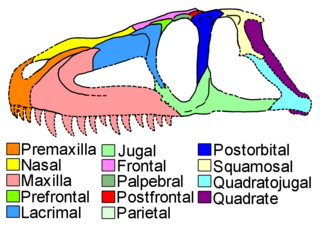
Luperosuchus is an extinct genus of loricatan pseudosuchian reptile which contains only a single species, Luperosuchus fractus. It is known from the Chañares Formation of Argentina, within strata belonging to the latest Ladinian stage of the late Middle Triassic, or the earliest Carnian of the Late Triassic. Luperosuchus was one of the largest carnivores of the Chañares Formation, although its remains are fragmentary and primarily represented by a skull with similarities to Prestosuchus and Saurosuchus.

Sillosuchus is a genus of shuvosaurid poposauroid archosaur that lived in South America during the Late Triassic period. Shuvosaurids were an unusual family of reptiles belonging to the group Poposauroidea; although their closest modern relatives are crocodilians, they were bipedal and lightly armored, with dinosaur-like hip and skull structures. Based on skull remains from members of the family such as Effigia, they were also toothless and likely beaked herbivores.
Yarasuchus is an extinct genus of avemetatarsalian archosaur that lived during the Anisian stage of the Middle Triassic of India. The genus was named and described in 2005 from a collection of disarticulated but fairly complete fossil material found from the Middle Triassic Yerrapalli Formation. The material is thought to be from two individuals, possibly three, with one being much more complete and articulated than the other. The type and only species is Y. deccanensis. Yarasuchus was a quadruped roughly 2–2.5 metres (6.6–8.2 ft) long, with an elongated neck and tall spines on its vertebrae. Unlike other quadrupedal Triassic reptiles, the limbs and shoulders of Yarasuchus were slender, and more like those of ornithodirans.
Arganasuchus is an extinct genus of "rauisuchian" (loricatan) archosaur. It is known from a single species, Arganasuchus dutuiti. Fossils of this genus have been found in Upper Triassic rocks of the Argana Basin, Morocco. Though its remains were initially referred to Ticinosuchus when discovered during the 1970s, in 2007 it was identified as a distinct genus with unique features of the pubis and maxilla. Arganasuchus also had several anatomical details in common with Batrachotomus, Fasolasuchus, and Postosuchus, though its relations with other loricatans remains unresolved. Arganasuchus is considered a carnivore due to its large, knife-shaped teeth.

Heptasuchus is an extinct genus of loricatan pseudosuchian known from the Middle or Late Triassic upper Chugwater Group of Wyoming, United States. It contains a single species, Heptasuchus clarki, the first formally recognized "rauisuchian" or loricatan pseudosuchian from North America.
Stagonosuchus is an extinct genus of loricatan, or possibly a species of Prestosuchus. Fossils have been found from the Late Triassic Manda Formation in Tanzania that are Anisian in age.

Loricata is a clade of archosaur reptiles that includes crocodilians and some of their Triassic relatives, such as Postosuchus and Prestosuchus. More specifically, Loricata includes Crocodylomorpha and most "rauisuchians", a paraphyletic grade of large terrestrial pseudosuchians which were alive in the Triassic period and ancestral to crocodylomorphs.
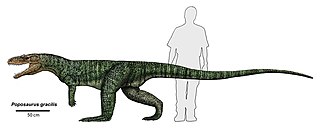
Poposauroidea is a clade of advanced pseudosuchians. It includes poposaurids, shuvosaurids, ctenosauriscids, and other unusual pseudosuchians such as Qianosuchus and Lotosaurus. It excludes most large predatory quadrupedal "rauisuchians" such as rauisuchids and "prestosuchids". Those reptiles are now allied with crocodylomorphs in a clade known as Loricata, which is the sister taxon to the poposauroids in the clade Paracrocodylomorpha. Although it was first formally defined in 2007, the name "Poposauroidea" has been used for many years. The group has been referred to as Poposauridae by some authors, although this name is often used more narrowly to refer to the family that includes Poposaurus and its close relatives.
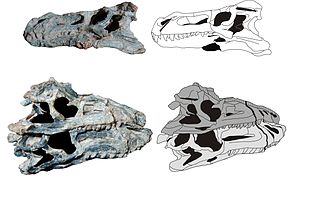
Decuriasuchus is an extinct genus of loricatan from the Middle Triassic period. It is a carnivorous archosaur that lived in what is now southern Brazil, in Paleorrota. It was first named by Marco Aurélio G. França, Jorge Ferigolo and Max C. Langer in 2011 and the type species is Decuriasuchus quartacolonia. The generic name means "unit of ten crocodiles" in Latin and Greek in reference to the ten known specimens and the animal's possible group behavior. The specific name refers to the Quarta Colonia region where the fossils were collected.

Paracrocodylomorpha is a clade of pseudosuchian archosaurs. The clade includes the diverse and unusual group Poposauroidea as well as the generally carnivorous and quadrupedal members of Loricata, including modern crocodylians. Paracrocodylomorpha was named by paleontologist J. Michael Parrish in 1993, although the group is now considered to encompass more reptiles than his original definition intended. The most recent definition of Paracrocodylomorpha, as defined by Sterling Nesbitt in 2011, is "the least inclusive clade containing Poposaurus and Crocodylus niloticus. Most groups of paracrocodylomorphs became extinct at the end of the Triassic period, with the exception of the crocodylomorphs, from which crocodylians such as crocodiles and alligators evolved in the latter part of the Mesozoic.

Shuvosauridae is an extinct family of theropod-like pseudosuchians within the clade Poposauroidea. Shuvosaurids existed in North America and South America (Argentina) during the Late Triassic period. Shuvosauridae was named by Sankar Chatterjee in 1993 to include the genus Shuvosaurus.
















